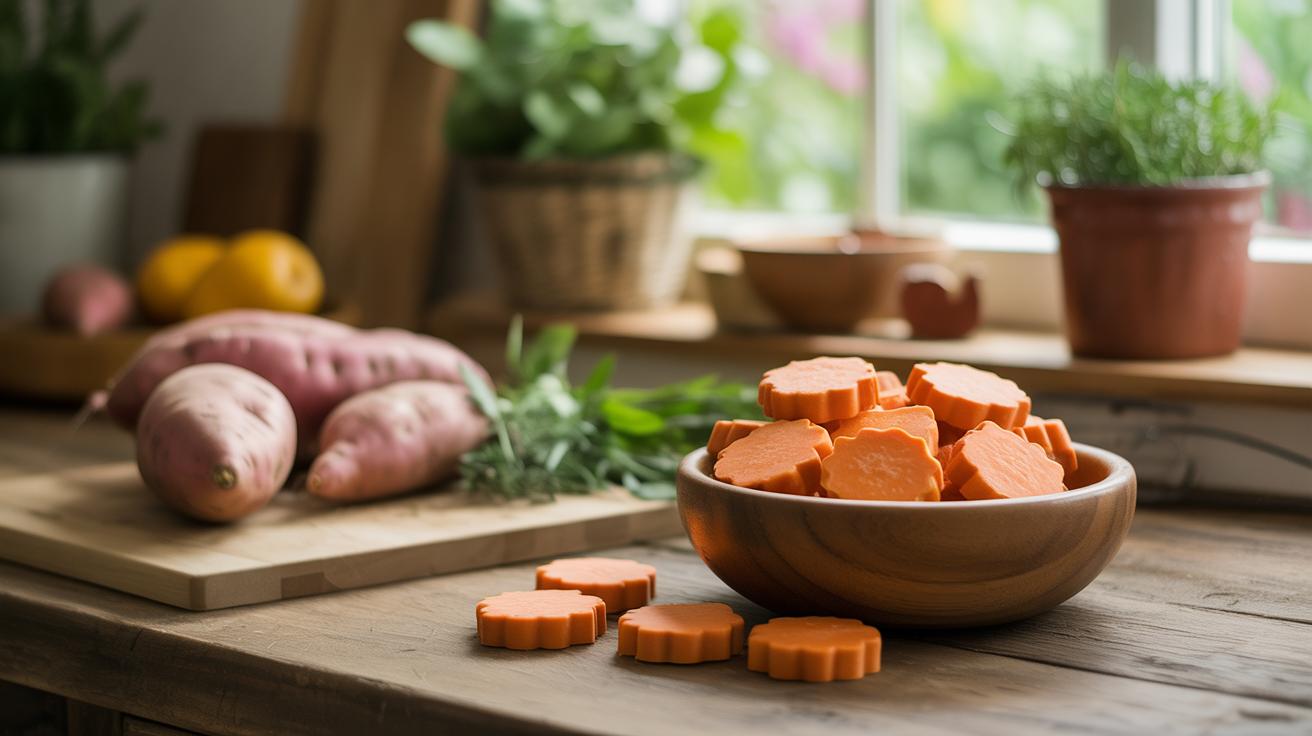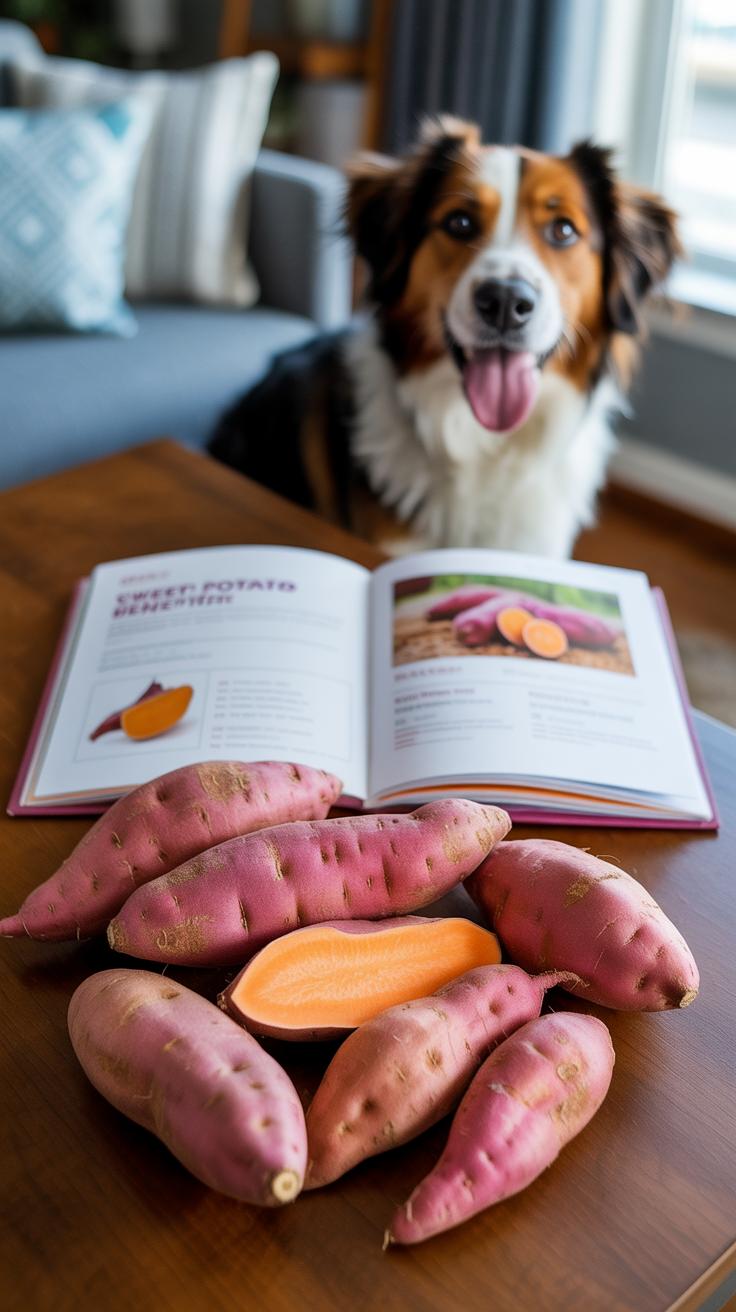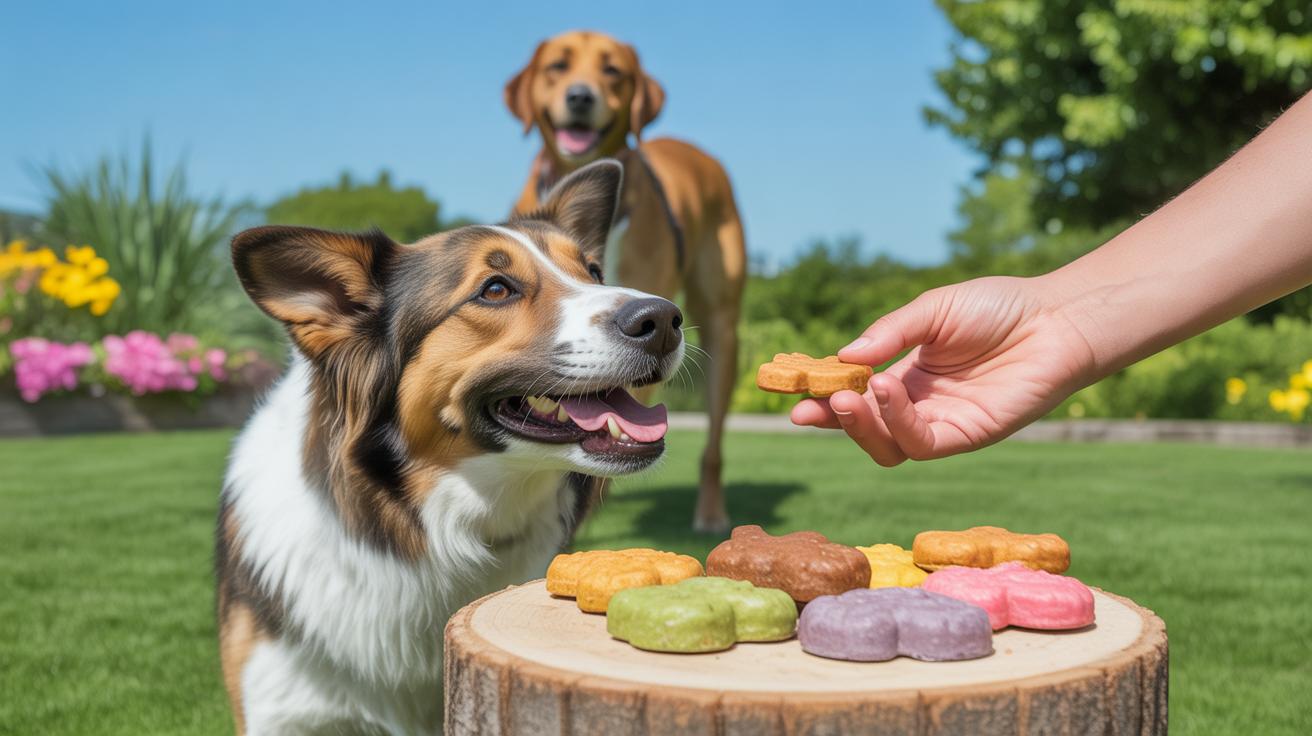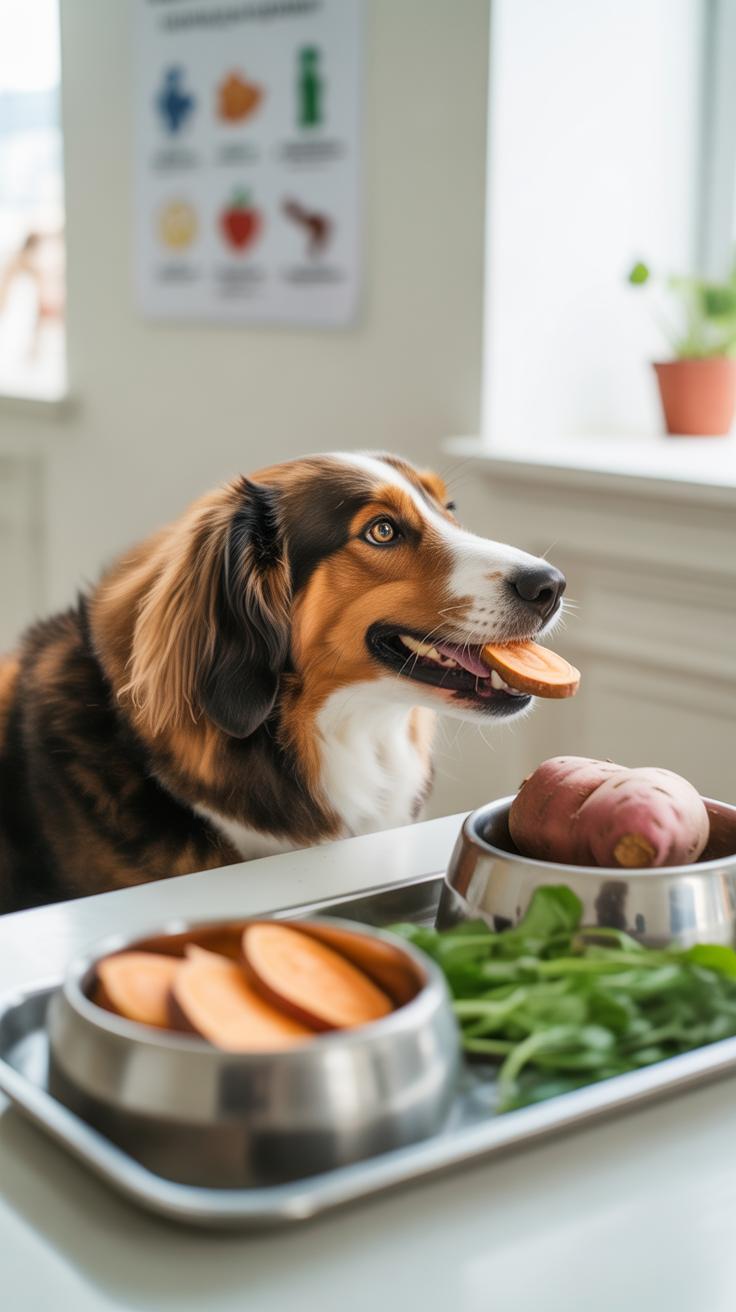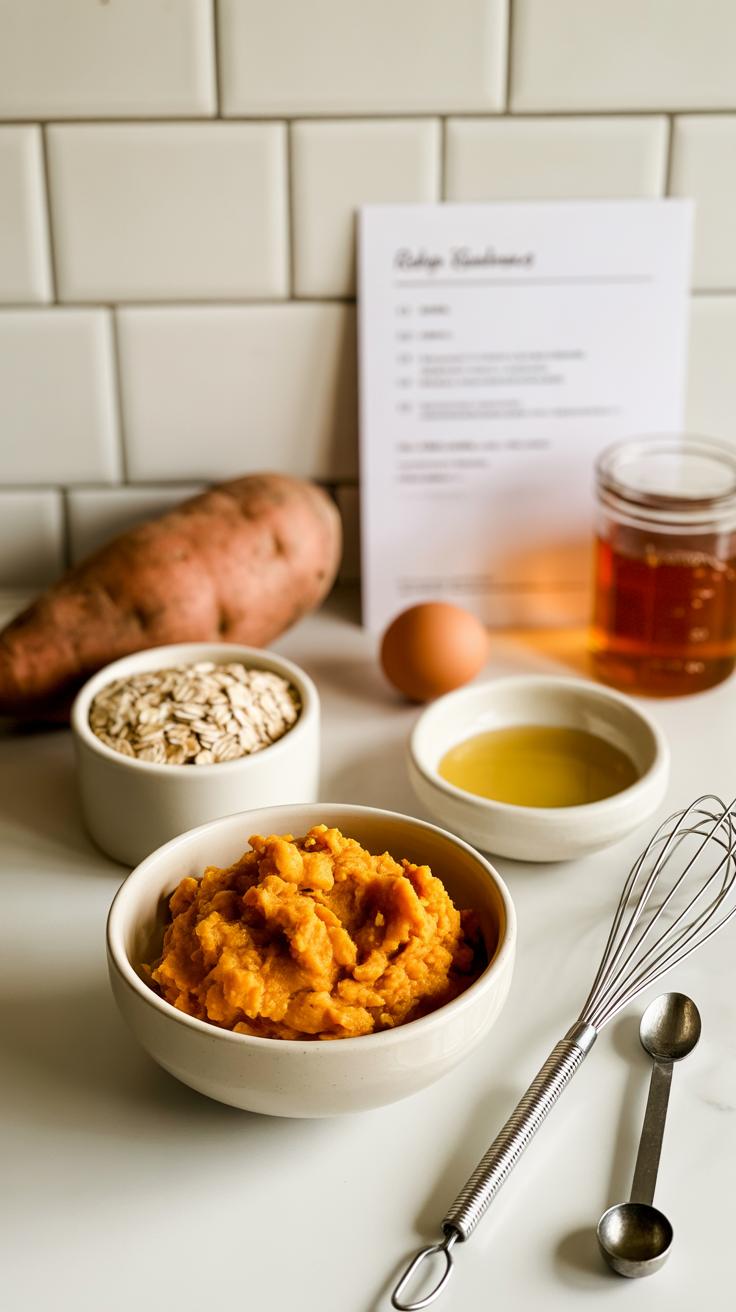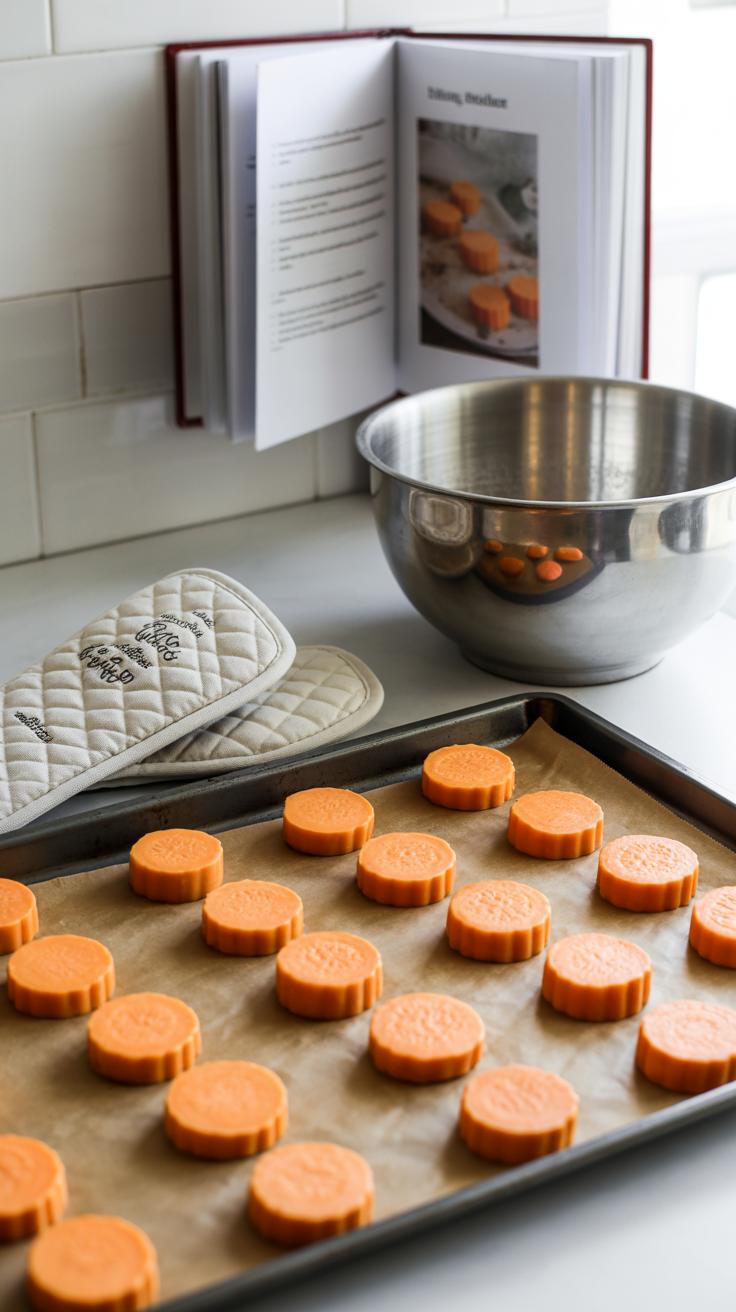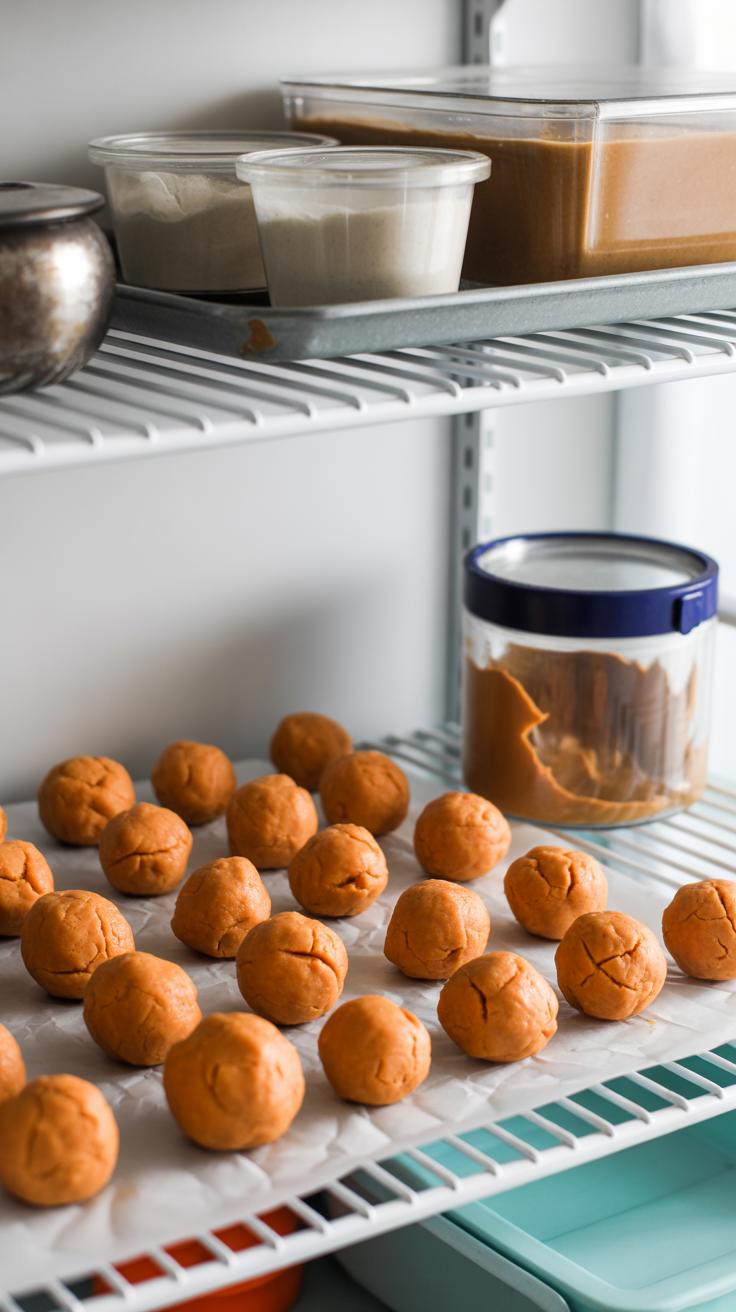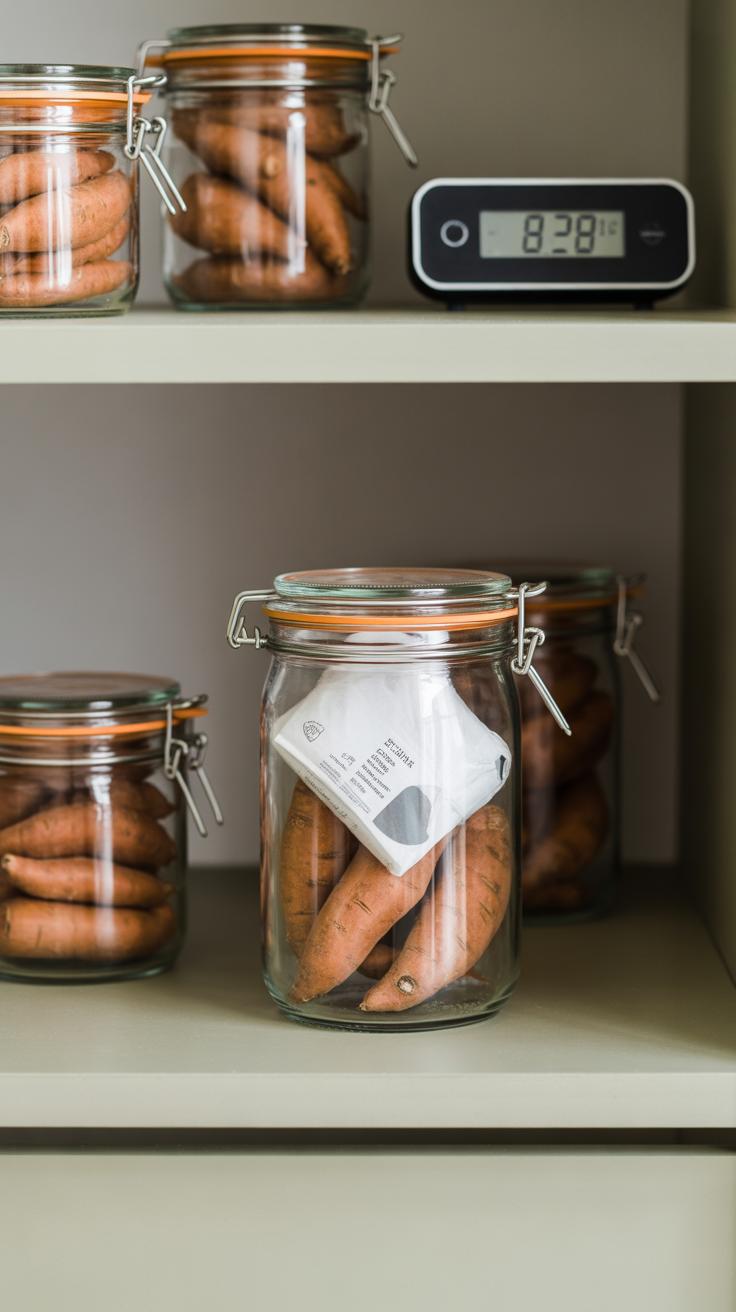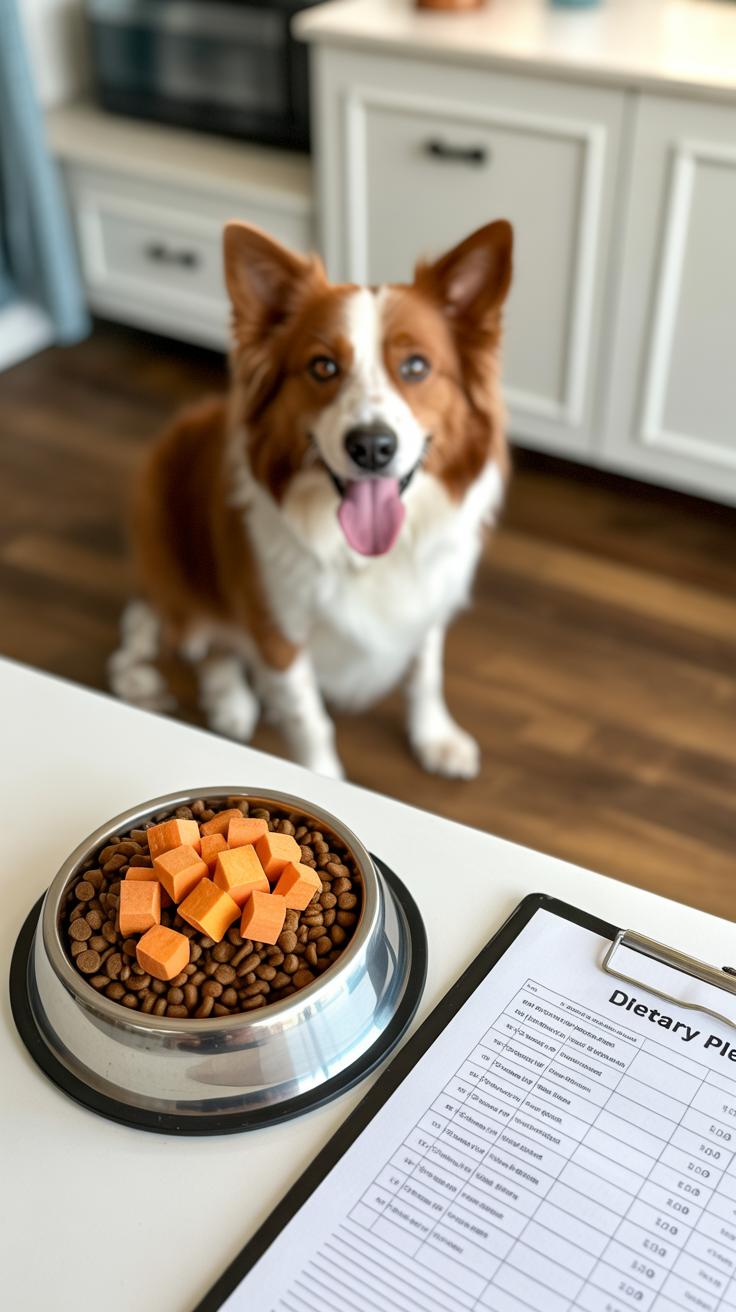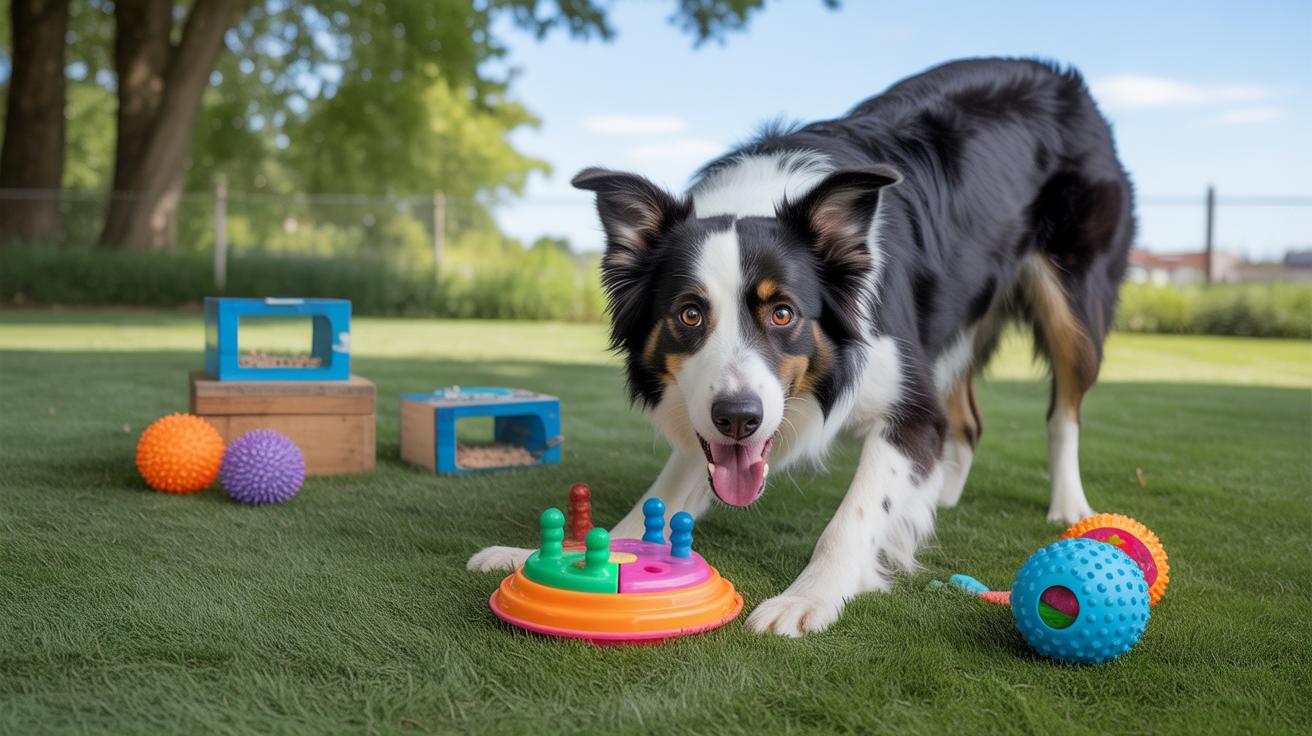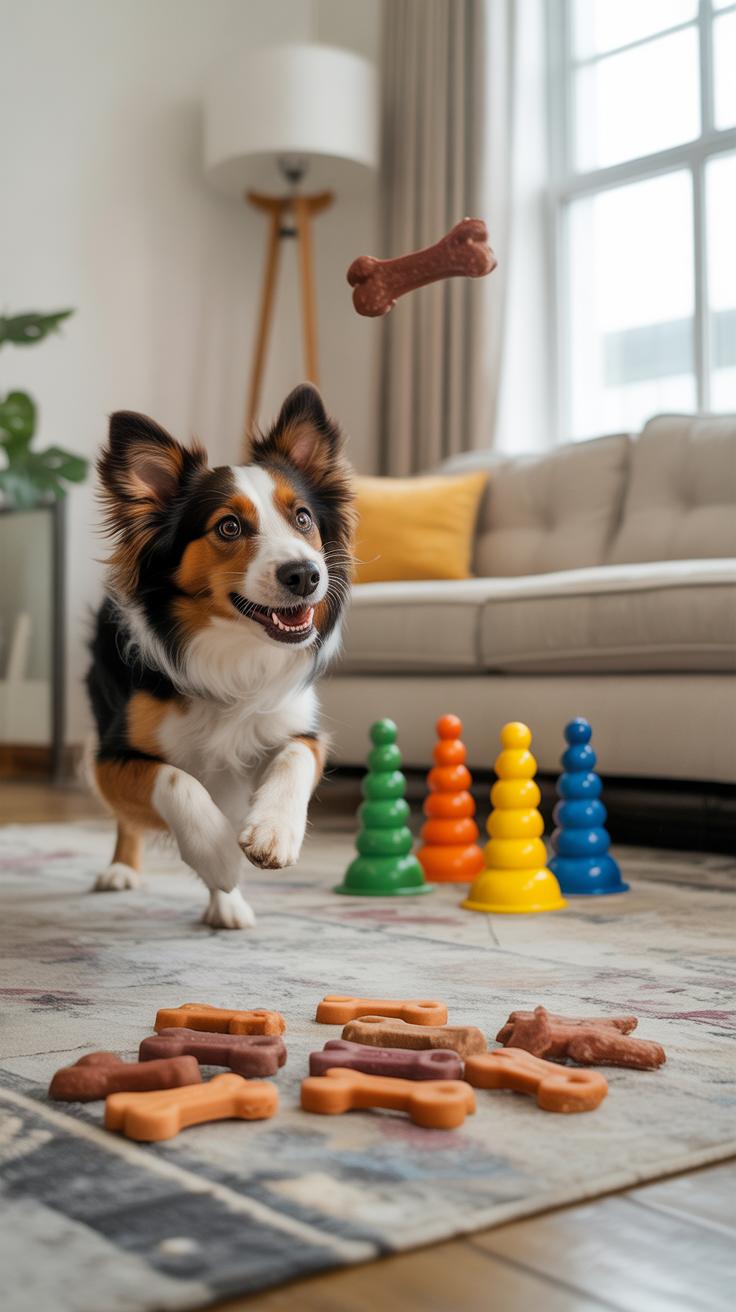Introduction
Making treats for your dog at home lets you control what goes into their snacks. Sweet potatoes are a great choice because they bring nutrients and taste that dogs love. These treats are simple to prepare and can add variety to your dog’s diet.
In this article, you will learn why sweet potatoes are good for dogs and find easy recipes to make your own treats. You will discover practical tips to keep your pup happy and healthy with nutrient-rich snacks made from sweet potatoes.
What Are Sweet Potatoes And Why They Matter
Sweet potatoes are a type of root vegetable, growing underground and storing nutrients in their tuberous roots. Unlike regular potatoes, which belong to the nightshade family, sweet potatoes are actually part of the morning glory family, which is kind of interesting when you think about it.
They come in a range of colors: the common orange-fleshed kind, white, purple, and yellow. Each color offers a slightly different profile in terms of taste and nutrients. Orange varieties are most popular, especially for dog treats, partly because of their natural sweetness and soft texture when cooked. But the purple ones, known for higher antioxidants, might be something to try if you’re feeling adventurous.
Sweet potatoes contain natural sugars, which give them a mild sweetness, but they’re also packed with fiber and vitamins. That combination makes them a good food choice—not just for humans, but for dogs too. They provide energy without unnecessary fats or additives, and their fiber helps with digestion. You might wonder if all these nutrients really make a difference in a simple dog treat, but they do add real value beyond the snack itself.
Sweet Potato Varieties And Characteristics
There are more types of sweet potatoes than you might expect. The most familiar are the orange-fleshed ones, which tend to be moist and sweet when cooked. Then there are white-fleshed sweet potatoes, which have a drier, more crumbly texture and a less pronounced sweetness. Purple sweet potatoes have a dense texture and a somewhat earthier, nuttier flavor. Yellow sweet potatoes fall somewhere between the two in terms of sweetness and texture.
For dogs, texture matters. Softer varieties like the orange type are gentle on their teeth and easier to digest. The purple one has some benefits but might be a little harder or drier, so it depends on your dog’s preference. I’ve noticed some pups prefer the sweeter taste, so the orange might win most rounds. Still, trying different types could keep snack time interesting.
Key Nutrients In Sweet Potatoes
Sweet potatoes are nutrient-rich, making them a valuable addition to your dog’s diet. Here are some key nutrients you’ll find:
- Vitamin A: Important for vision, immune system support, and skin health.
- Vitamin C: Aids in healing and boosts immunity.
- Fiber: Helps regulate digestion and promotes gut health.
- Potassium: Supports muscle function and heart health.
- Iron: Contributes to healthy blood circulation.
These nutrients work together to support your dog’s overall wellbeing. Fiber, for example, isn’t just about regular stools—it might help with feeling full, which can prevent overeating. Vitamins A and C support immune health, which is something all dog owners quietly hope for. It’s a complex mix, but the simple fact is that sweet potatoes bring more to the bowl than just flavor.
Why Sweet Potato Treats Are Good For Dogs
Sweet potatoes offer quite a few benefits that seem especially suited for dogs. One key advantage lies in their fiber content. That fiber can help keep your dog’s digestion running smoothly, which is no small thing. Constipation and other digestive hiccups can be uncomfortable and frustrating for dogs, and sweet potatoes often lend a gentle hand here. It’s not just about avoiding problems though; fiber also promotes regular bowel movements and can improve gut health over time.
But sweet potatoes do more than help digestion. They bring vitamins A and C to the table, which support immune function and energy levels. Vitamin A plays a role in maintaining healthy skin and vision, while vitamin C helps protect cells and supports the immune system. You might notice your dog has more pep in their step after a steady diet including these treats — though that could partly be the excitement of a tasty snack!
So, when you give your dog sweet potato treats, you’re not just offering something tasty — you’re contributing to overall health. Fiber, vitamins, and a gentle energy boost combine to keep your dog feeling good. It makes you wonder why more commercial treats don’t lean into sweet potato as a go-to ingredient, doesn’t it?
Simple Ingredients For Homemade Sweet Potato Treats
Choosing ingredients for homemade sweet potato dog treats can feel a bit tricky at first. You want to keep it natural and safe, but it doesn’t have to be complicated. Sweet potatoes pair well with a handful of everyday things you might already have in your kitchen.
Choosing Dog-Safe Additions
Oats are a popular choice—they add fiber and a bit of chewiness without upsetting your dog’s tummy. Plus, most dogs tolerate oats well, even if they have mild allergies. Peanut butter is another favorite. Just make sure it’s free from xylitol, which is dangerous for dogs. The fats in peanut butter help keep treats tasty, making them a hit with picky pups. Some people also mix in a little cinnamon, which can add flavor and some antioxidants, but in very tiny amounts.
Other simple options include plain pumpkin puree or unsweetened applesauce. These not only add moisture but also supply extra vitamins without any artificial stuff. You might wonder—should you add eggs? They’re actually great for binding ingredients and provide protein, but if your dog has allergies, you might want to skip them or try alternatives.
Avoiding Harmful Substances
It’s really crucial to steer clear of common human treat ingredients that could harm your dog. For example, chocolate, grapes, raisins, onions, and garlic are obvious no-nos. But also watch for artificial sweeteners like xylitol, which can sneak in especially with peanut butter or other nut butters. Salt and sugar don’t belong in dog treats either, and they offer no benefits besides possibly masking the natural flavors.
Sometimes people add nuts like macadamia nuts or walnuts, thinking they’re healthy, but they can cause serious problems. Even some spices often used in baking, like nutmeg, are toxic in small doses. So it’s best to stick with a short list of ingredients you know are safe.
Finding the right balance between nutritious and simple isn’t always obvious. But by sticking to a few trusted, dog-friendly ingredients that go well with sweet potatoes, you make treats your dog can enjoy without worry. What’s your dog’s reaction to new flavors—do they prefer plain treats or are they open to little experiments like cinnamon or pumpkin?
Recipe For Basic Baked Sweet Potato Treats
Preparation Steps
Start by washing your sweet potatoes well, scrubbing off any dirt—you don’t want grit sneaking into the treats. Peeling is optional. I usually leave the skin on because it has extra fiber and nutrients, plus it keeps the treat a bit firmer. But if you prefer a smoother texture, peeling is fine. Slice the sweet potatoes into even rounds or strips, about a quarter-inch thick. Thinner slices bake more quickly and get crispier, while thicker ones stay softer inside. You’ll have to decide what your dog prefers. I’ve found that dogs often enjoy a mix of both textures.
Baking And Storage Tips
Preheat your oven to 250°F (120°C). Lay the slices flat on a parchment-lined baking sheet, making sure they don’t overlap. Bake for roughly 2 to 3 hours—yes, a bit of patience is required here. The treats are done when they’re dried and slightly crisp but not burned. Checking around the two-hour mark is a good idea; ovens vary and so does thickness.
Once cooled, store the treats in an airtight container. They keep well at room temperature for about two weeks. If you want to keep them longer, refrigeration can stretch shelf life to a month, or freeze for a few months. Just thaw before giving them to your dog. I like to test one after baking with my fingers—it should snap cleanly or bend without crumbling. If you’re unsure, your dog’s sniff test is the final verdict.
NoBake Sweet Potato Treat Options
Not every homemade dog treat needs to go into the oven. Sometimes, you want something quicker, simpler—less mess, less waiting. That’s where no-bake sweet potato treats come in handy. These options save time and still let you give your dog a tasty, nutrient-rich snack without fuss.
Raw Sweet Potato Slice Treats
One of the easiest treats you can prepare is simply slicing raw sweet potato into thin rounds or strips. Just wash the sweet potato well and slice it evenly. These raw slices offer a nice crunch that some dogs seem to love—plus, chewing on them can help keep teeth clean. The fiber and vitamins remain intact since there’s no cooking involved. It’s like giving your dog a mini vegetable chip, but healthier. I’ve noticed my own dog enjoys these for quick chew sessions, especially on busy days when I don’t have time to bake. Do watch for any signs of chewing difficulty, though—some dogs prefer softer treats.
Mixing Sweet Potato With Peanut Butter
If crunch isn’t your dog’s thing, consider mixing mashed sweet potato with peanut butter for soft, no-bake bites. Mash boiled or steamed sweet potato until smooth, then mix in a spoonful or two of plain, unsweetened peanut butter. You get this creamy, slightly sticky mix that’s easy to shape into small balls or dollops on parchment paper. These treats are rich, perfect for dogs who might struggle with harder snacks. Plus, peanut butter adds a nice protein kick, and most dogs love the taste. You could even freeze them for a cooler snack on warm days. Just be sure you’re using peanut butter without added sugars or xylitol, which is toxic for dogs.
How To Store Sweet Potato Treats To Keep Them Fresh
Once you’ve made your sweet potato dog treats, the next step is figuring out how to keep them fresh and safe for your furry friend. Treats can dry out or even grow mold if left out too long, so storing them properly makes a big difference.
Refrigeration And Freezing Methods
For short-term storage, the fridge works well. Place the sweet potato treats in an airtight container or a resealable bag to prevent them from absorbing odors or drying out. Usually, they’ll stay good for up to a week in the fridge. If you find that’s not long enough, consider the freezer.
Freezing can extend freshness significantly. You could freeze treats in single portions inside small containers or sandwich bags, so you only thaw what you need. They can last up to three months in the freezer. When thawing, just move them into the fridge a day before or leave them out at room temperature for a short time. Avoid refreezing thawed treats since that might affect texture and quality.
Shelf Life And Signs Of Spoilage
Homemade sweet potato treats don’t have preservatives, so their shelf life is shorter than store-bought ones. At room temperature, they usually last no more than two to three days before starting to get soft or stale. But, if you notice any unusual smell, mold, or discoloration—better to toss them out immediately. Sometimes subtle changes, like slight stickiness or off-taste, mean spoilage, even if no obvious mold is visible.
Have you ever given a treat and wondered if it was still good? Trusting your senses helps a lot. When in doubt, it’s safer to discard old treats rather than risk your dog’s health. I’ve found that keeping a small weekly batch and storing extras in the freezer strikes a good balance between freshness and convenience.
Incorporating Sweet Potato Treats Into Your Dogs Diet
Sweet potato treats can make a great occasional snack for your dog, but like with any treat, moderation is key. You don’t want these goodies to replace regular meals or throw off your dog’s overall nutrition. Think of them as extras – not the main event.
How often? Once or twice a week seems reasonable for most dogs, but it really depends on your pet’s activity level, weight, and overall health. Some dogs might enjoy them more frequently, but watch for any digestive changes or weight gain. Too many treats, even healthy ones, can add up.
Serving Sizes And Frequency
Proper portion control matters. Smaller dogs need just a bite-sized piece, maybe one or two small treats per day if you decide to give them daily. Medium to large dogs can handle a few more, but there’s no need to overdo it.
- Small breeds: 1-2 small pieces per treat session
- Medium breeds: 2-3 pieces
- Large breeds: 3-5 pieces
Frequency should ideally stay limited to a few times a week. Overfeeding treats of any kind can lead to weight gain and might cause your dog to refuse their normal meals. So, keep an eye on portions whether it’s sweet potato or something else.
Balancing Treats With Regular Meals
When you add treats like sweet potato snacks to your dog’s diet, their meal portions might need slight adjustment. If you hand out treats without cutting back on meal portions, you risk excess calories. That’s especially true if your dog isn’t particularly active.
Try to think about treats as part of your dog’s total daily calorie intake. If your dog gets two treats, maybe reduce the meal size a little bit. You may find this balancing act a bit tricky at first, but it becomes easier as you watch your dog’s weight and energy over time.
Also, remember that sweet potato treats do provide some nutrients, so they aren’t empty calories like some commercial treats. This makes sneaking a few extra pieces a tad less concerning, but moderation still matters here.
Tips For Making Treat Time Fun And Healthy
Using sweet potato treats during training or play offers a chance to deepen your connection with your dog. When your dog responds well to a command and you follow up with a tasty reward, it reinforces positive behavior. It’s more than just the treat—it’s about sharing a moment where both of you are engaged and attentive.
Try mixing small training sessions into daily routines, like practicing “sit” or “stay” before mealtime. Sweet potato treats are gentle on the tummy, so you won’t have to worry about overdoing it but still keep your dog motivated. I find that breaking treats into tiny pieces works better than whole ones because it keeps the flow going without rushing to the end.
Pay attention to the size and texture of the treats, especially if your dog is young or older. Soft, chewy pieces are easier to handle and digest, preventing any discomfort. For tougher treats, you can try soaking them briefly in water to soften them, making them more manageable for sensitive teeth.
Here are a few simple tips to keep treat time healthy and appealing:
- Start with small, bite-sized pieces to avoid overfeeding and support healthy weight.
- Store treats in an airtight container to keep freshness and prevent them from becoming stale or hard.
- Observe how your dog reacts—if they seem disinterested, try switching up texture or cutting size before moving on.
- Limit the number of treats per session to avoid spoiling appetite for regular meals.
Do you find your dog gets distracted easily during training? Sometimes switching the location or the timing of treat rewards can rekindle interest. The key is to keep the experience positive and enjoyable for both of you. After all, treat time isn’t just about the snack—it’s about building trust and shared routine.
Conclusions
Sweet potato dog treats are a simple way to add nutritious snacks to your dog’s diet. They offer vitamins, fiber, and energy your dog needs. Making treats at home is also a good way to ensure natural ingredients and avoid fillers found in some store-bought snacks.
You can start with easy recipes and tailor snacks to your dog’s tastes and needs. Homemade sweet potato treats not only nourish your dog but also strengthen your bond through shared care. This is an easy step you can take for your dog’s health and happiness.

